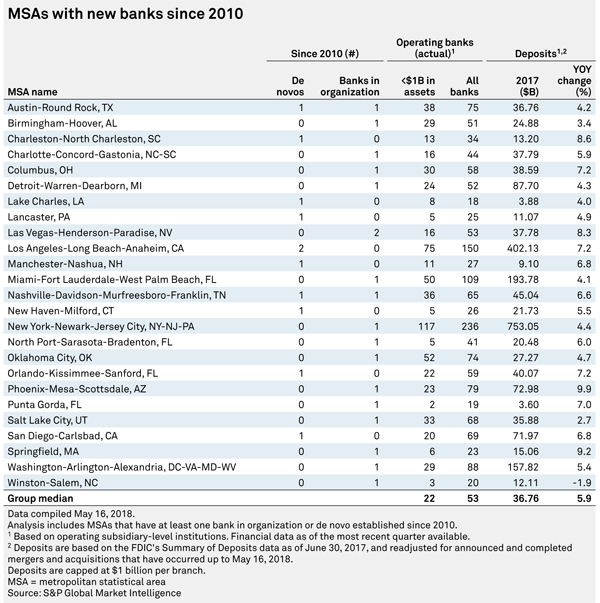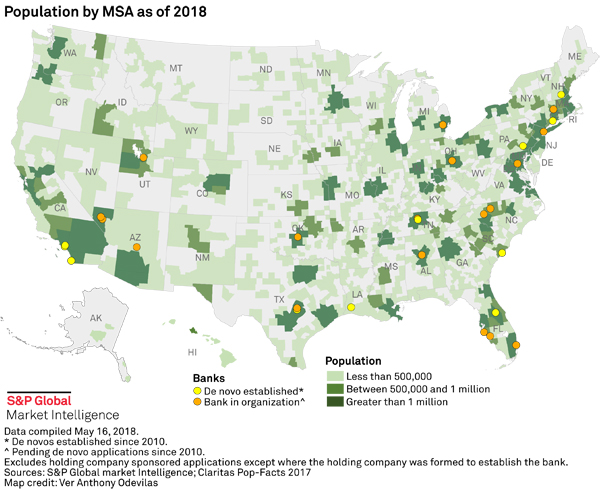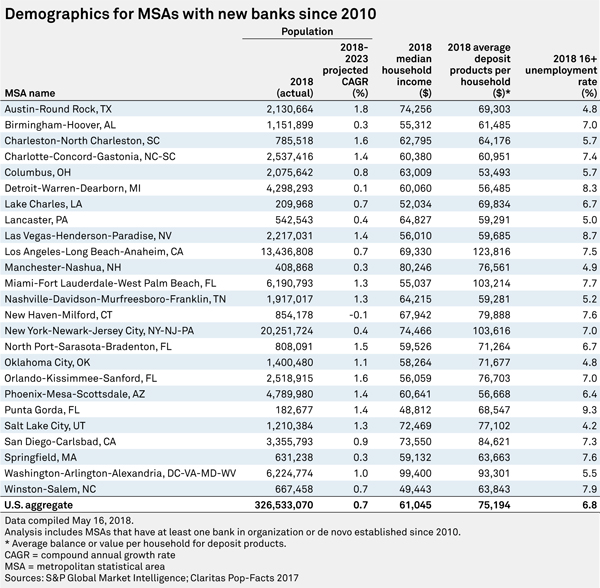De novo organizers following the crowds
New banks begin sprouting again
- |
- Written by S&P Global Market Intelligence
 S&P Global Market Intelligence, formerly S&P Capital IQ and SNL, is the premier provider of breaking news, financial data, and expert analysis on business sectors critical to the global economy. This article originally appeared on the SNL subscriber side of S&P Global's website.
S&P Global Market Intelligence, formerly S&P Capital IQ and SNL, is the premier provider of breaking news, financial data, and expert analysis on business sectors critical to the global economy. This article originally appeared on the SNL subscriber side of S&P Global's website.
By Kelsey Bartlett and Zain Tariq, S&P Global Market Intelligence staff writers
Following years of sluggish activity, de novo banks are cropping up across the nation at a more rapid pace.
Eleven banks have received application approvals since 2010. Applications are pending for another 18 institutions, with the majority filed in 2017 and 2018. Most are located in highly populated areas—a trend industry experts expect to continue.
Donald Musso, president and founder of consulting firm FinPro Inc., said for the most part, de novo organizers are gravitating toward "high-growth, low-tax, red state" markets. He expects the "explosion" of new banks to be in growing metro areas, like Charlotte, N.C.; Charleston, S.C.; and Nashville.
While Musso does not expect the number of de novos to return to pre-crisis levels—when there were upwards of 100 new banks a year—he anticipates up to two dozen new banks could open annually in the U.S.
"I think it's all going to be concentrated in the urban areas, where the millennials and where the empty-nesters are fleeing," Musso said.
Jeffrey Sullivan, the proposed CEO of Springfield, Mass.-based New Valley Bank & Trust, said consolidation, coupled with rising rates and an improving regulatory environment, made 2018 the right time to open a bank.
New Valley Bank & Trust, which would be the only bank headquartered in Springfield, hopes to have a regional identity, and its economic existence will depend on the Connecticut River Valley.
"If you look a little more broadly across Massachusetts, there's definitely a scarcity of small lenders," Sullivan said in an interview. "The lid came off on M&A activity a few years ago, and several of those small banks disappeared."
There have been 60 bank and thrift deals in Massachusetts since 2008, according to S&P Global Market Intelligence data. Six of the sellers were located in the Springfield metro area.
Michael Jamesson, head of consulting firm Jamesson Associates, said de novos may be forming in or near heavily populated areas because investors want a profitable exit strategy in years to come.
"That seems to be the place that if there are independent, smaller institutions, the big banks tend to want to buy into those markets and pay higher premiums," Jamesson said.
Musso warned that organizers should be careful to avoid potentially overheated markets, referencing Atlanta in the early 2000s, when scores of new banks opened their doors and failed.
"The question is: What's the right number for the market?" Musso said. "Is it one? Is it two? I seriously doubt it's three. So the other thing for de novo groups to start to think about is: First-in wins."
Jamesson said regardless of an uptick in de novos, he still expects there to be fewer banks in five years.
This article originally appeared on S&P Global Market Intelligence’s website on May 21, 2018, under the title, "De novo organizers following the crowds"
Tagged under Management, Financial Trends, Blogs, Community Banking, Feature, Feature3,
Related items
- Inflation Continues to Grow Impacting All Parts of the Economy
- Banking Exchange Hosts Expert on Lending Regulatory Compliance
- Merger & Acquisition Round Up: MidFirst Bank, Provident
- FinCEN Underestimates Time Required to File Suspicious Activity Report
- Retirement Planning Creates Discord Among Couples

















